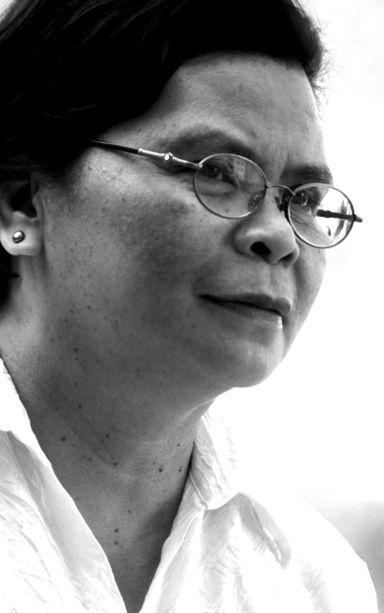
DELACERNA
We carry the heart and soul of the Filipino.
Graduations are somber affairs. The sight of halls filled with long, dark togas and mortarboard caps are part of an age-old tradition of academia, one borrowed from universities in Europe that took shape in the 12th and 13th centuries.
That visual no longer holds true for the iskolar ng bayan.
In an enlightened nod to Filipino heritage, candidates for graduation in UP campuses walk with dignity to receive their diplomas wearing an ecru dress or Barong Tagalog with a sash that hangs from shoulder to thigh.
The sablay draped across the body is the official academic costume of UP officially adopted in 2000 after its first appearance in UP Diliman in 1990.
Created by six professors from UP Diliman, the sablay is inspired by the malong of Muslim Mindanao, a loose garment made from a seamless bolt of cloth.
A closer look at the original design, which has a copyright registered in 2002, reveals elements of native Philippine culture. The letters “U” and “P” are repeated in ancient Babayin script, also known as alibata, an alphabet used by our pre-Spanish forbears. The university colors of maroon and green frame strokes rendered in yellow gold.
Hand-woven material is chosen to “represent hard work and Philippine indigeneity.”
With a design more suited for the tropics, students and faculty members are grateful for the light-weight garb. To this change is credited fewer episodes of “fainting” and complaints of unbearable heat-induced sweating under gothic gowns.
The appeal of the alternative attire is also in its layers of meaning.
As a verb, sablay means to place a precious object like a piece of cloth or garment upon one’s shoulder as a gesture of respect. In Cebuano, sablay (also sagbay) means to take upon the shoulder, to bear a burden, to assume a responsibility.
With this, graduates are reminded of the social obligation they carry in a world beyond the classroom, according to Prof. Henry Francis Espiritu, philosophy teacher in UP Cebu.
“The sablay is the fabric of nation-building,” he said. “It is woven and is always rectangular. Its seamless nature shows that the development of the nation should be holistic. The designs are symbols of the contributors of different ethnic groups.”
Simple, yet elegant, the updated look is welcomed by young adults who see it as a symbol of struggle and success.
Like a hard-earned diploma, “it has become a goal for millennials,” said Jae Marie Magdadaro, a fresh psychology graduate. “It reminds us that success needs careful weaving. The word sablay gives it a positive meaning,” she said.
In current protocol, the sash is worn on the right shoulder. It is moved to the left shoulder by the presider after the candidate is conferred his or her degree. This echoes the traditional gesture of flipping the tassel of an academic cap from one side to the other.
The sablay is supposed to be worn over formal dress in ecru (cream or beige) for females with formal shoes or an ecru Barong Tagalog and black pants for males.
Some students take playful liberties with the attire that may call down the university “fashion police.” A retired professor in one campus sighed when she recalled seeing some graduating students do the following: sling the sablay as if it were a bath towel; preen with the sash to play-act the triumph of a pageant winner; and pair the sablay with a mini-dress and bare shoulders in spaghetti straps.
Out of respect, the sablay should be worn only during academic functions and with dignity. One student wore his Barong Tagalog and sablay with black rubber shoes. Where is the reverence there?
Over the years, one can expect the sash design to evolve even as standards need to be clarified. Amid other suggestions to adopt design variants, UP resident Alfredo Pascual formed a system-wide Committee on the Sablay in July 2013 “to conduct an extensive study on its design and various practices on its use in each constituent university of UP,” to study unique features for different academic degrees and set guidelines.
The committee recommended creating a Brand Standards Manual or Brand Book. Purchase orders have to be placed with licensed suppliers such as the Iloilo City–based Arevalo Handwoven Products and Maroons in the UP Diliman Shopping Center.
The description of the sablay in the UP website of the Office of the Vice Chancellor for Research and Development specifies the exact shade of maroon, green and yellow to be used based on a Pantone ProSim color chart.
Other details state: “The curvilinear design called ukkil or ukit, which resembles a sprouting plant, signifies life. The geometric designs (in zigzag diamond patterns) are common design elements gracing the attires and functional objects of indigenous peoples from Batanes to Tawi-tawi…(these) highlight the diverse cultural communities in the Philippines and the University’s pursuit of knowledge, cultural enrichment, and scientific advancement.”
The alternative to the Western toga has set a trend. A number of non-UP schools now use a sablay for their commencement rites with their own logo.
Nostalgia for the traditional toga is still there. Some academics, especially those who graduated from distinguished universities abroad, prefer the classic cap and gown to identify UP among its peers.
But the change is being embraced wholeheartedly by those who expect UP to shake the status quo instead of blending in. More than a symbol of honor, it conveys a mission.
“The sablay is worn by both students and teachers during graduation,” says journalism professor Mayette Tabada. “It reminds me how we are all lifelong learners sharing the stake to serve the Filipino nation.”
Dr. Phoebe Zoe Sanchez, who teaches sociology in UP Cebu, said the sash hung on one’s shoulder “has social meaning” that grounds the university in its identity as a creation of government but one that ultimately belongs to the people.
Wearing the sablay means: “We are struggling scholars … we carry with us the heart and soul of the Filipino.”